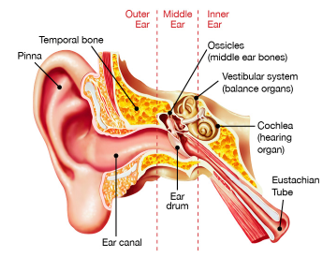What is middle ear fluid?
For ears to work properly, the middle ear needs to be full of air. The Eustachian tube, which usually does this, joins the middle ear to the back of the nose. In children, this tube is not as vertical and does not work as well as it would in an older child or adult. If the Eustachian tube becomes blocked, air cannot enter the middle ear. When this happens, fluid produced by the lining of the middle ear becomes trapped. This starts off like a runny liquid and the longer it stays trapped in the middle ear, the thicker it becomes. When this fluid becomes infected it can cause an ear infection. This condition is also otherwise known as ‘glue ear’.

With fluid blocking the middle ear, it becomes harder for sound to pass through to the inner ear. This can make quieter sounds difficult to hear. If your child has middle ear fluid they can’t always hear everything that you say, and it often appears that they have ‘selective deafness’.
Middle ear fluid in children
Middle ear fluid is a common childhood condition. It mainly occurs in children under the age of seven, although it can persist into adolescence. Middle ear fluid can cause temporary deafness, delayed speech development in young children and affect a child’s behaviour and educational progress.
Middle ear fluid is often, but not always, linked with ear infections. It can sometimes develop unnoticed. Changes in behaviour, becoming tired and frustrated, lack of concentration, preferring to play alone and not responding when called may indicate middle ear fluid. These signs can often be mistaken for stubbornness, rudeness and being naughty. As a result many children with middle ear fluid are misunderstood or labelled as ‘different’.
What treatments are available?
Audiology
An audiological assessment will help to identify middle ear fluid:
- A tympanometry test, measures how well the eardrum moves and can indicate if there is fluid in the middle ear.
- A hearing test will indicate if middle ear problems are affecting your child’s hearing.
Often middle ear fluid is associated with a heavy cold and will clear up when the congestion from the cold has gone. It is important to consult your GP to see if there is any sign of ear infection so appropriate treatment can be carried out. It is a good idea to monitor the middle ear fluid with repeated tests several weeks apart. For most children, middle ear fluid will clear up in this time. If the symptoms continue, your GP (sometimes in consultation with an audiologist) may choose to refer your child to an ear, nose and throat (ENT) specialist to consider other forms of treatment, including grommets.
Grommets
These are tiny plastic tubes that are put in the eardrum. This is done during a short operation at hospital under general anaesthetic. Grommets are inserted after the middle ear fluid has been drained. The grommets allow air to circulate in the middle ear and stop the build-up of more fluid. Grommets usually stay for six-12 months then fall out once the ear has healed. If your child has grommets it is very important to keep water out of the ears, as this can cause further infection. Sometimes if the fluid returns, another set of grommets may be considered.
How can I make hearing easier for my child?
It is important that middle ear fluid is identified as soon as possible and that parents and teachers know how it can affect children’s hearing. Basic communication tips can help to make listening easier for your child:
- It is important to get your child’s attention before you start talking. Make sure you face your child as much as possible, and keep eye contact.
- Check that background noise is kept to a minimum. Speak clearly, without shouting and maintain your normal rhythm of speech. Check that your child has understood what you have said, by asking him or her to do something or repeat what you said.
- It is important you tell your child’s teacher about your child’s hearing so that arrangements can be made in school to help. Your child should sit near the teacher in the classroom, so that he or she understands what is said and is comfortable with asking for things to be repeated.
For current information on Middle Ear Fluid, please view the fact sheet here.
